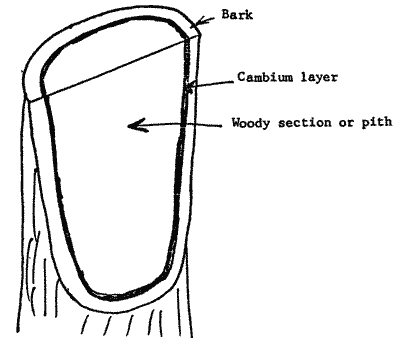
MORE ABOUT GRAFTING
The practice of grafting has a history stretching back to the period 1000 BC. Both the Chinese and the Romans developed and documented techniques for grafting, using the limited materials available at that time. Little was known of the physiological criteria for a successful grafting operation, compared with present knowledge of this subject. Modern technology has allowed the development of generally reliable grafting methods. Most of the cool-growing food plants have been adequately researched for their respective graft method suitability, but further development is needed for some tropical species.
The aim of grafting is to connect pieces of living tissue in such a way that they will form and behave as one plant. As you may imagine, there are a multitude of ways to achieve this end, but several common and reliable methods have evolved. Each species has a graft method preference during a particular stage of growth.
There are several benefits to be gained from the practice of grafting food plants. Apart from the advantages of clonal propagation, grafting provides for:
1. Even growth rates.
2. Earlier and even bearing properties.
3. Root rot resistance from selected rootstocks.
4. Tolerance to adverse soil conditions with selected rootstocks.

The Fundamental Grafting Principle
Ultimately, the success of a grafting operation depends on the matching of cambium layers. Cambium layers are found just under the bark of plants, and are the important growth or healing zones in the grafted areas. If the cambium layers are not in intimate contact, there can be no translocation of water or nutrients to the scion - resulting in its death.
Matching the cambium layers is not the same as making a flush-looking graft union, because bark thicknesses vary, depending on age, species and growth rate of the material.
Incisions are made into the scion and stock to conform to these principles, using razor-sharp implements to cut, not tear, the material. Avoid disease transfer from outside sources by ensuring that implements and hands are sterilized before contact with cut surfaces.
The grafted surfaces should be bound together tightly with plastic tape, to further improve cambium contact. This will also seal the union from adverse weather conditions. Details of individual techniques are available in Departmental crop summaries.
Post Graft Care
The scion should be afforded protection from desiccation because its nutrient and water supply have been temporarily interrupted. To provide this protection, the scion is usually defoliated before grafting, then wrapped in plastic after the operation. A plastic bag may be tied into position, or one may use the grafting tape to wrap around the scion. It is not always essential to defoliate the scion, but present research suggests that leaves are generally a liability to the scion's health.
As the scion grows, any growths from the rootstock section should be suppressed to aid the development of the scion. The establishment of the grafted plant should involve a gradual exposure to the final site conditions. The plastic bag should be removed over several days, with the plant being manipulated to avoid extremes of light, temperature and water.
The development of your grafting technique is a process which becomes more fluent with practise. Professional grafters and budders can perform 2000 operations per day, with 95-100% success. The most important aspect to remember is the matching of the cambial regions by cutting smoothly and, eventually, confidently.
DATE: January 1981
* * * * * * * * * * * * *
